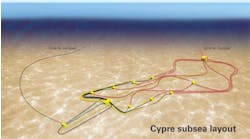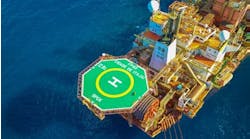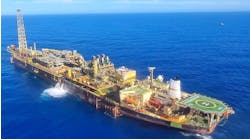Terra Nova will be the setting for Newfoundland - and North America's - first crude production vessel. Also, it will be the first use of an FPSO in a pack ice environment. A platform with a gravity base structure, on the lines of Hibernia, was discounted for three reasons, explained Petro-Canada's Gregory Lever in his presentation at last month's 14th Annual Floating Production Systems Conference in London, organized by IBC Global Conferences:
- Terra Nova has less oil than Hibernia.
- The 95-meter water depth there is deeper than at Hibernia.
- The seabed conditions militated in favor of an FPSO.
Lever, who is Offshore Development and Operations Manager for the project, related the rationale behind some of the complex design issues. The reservoir comprises three fault blocks - Graben, East Flank, and Far East - with reservoir sands located 3,200 meters below the seabed. Five delineation wells have identified five major and two minor oil-bearing sands.
No gas cap or natural water drain has been found within the reservoir, so injection is required to maintain reservoir pressure in order to maximize oil recovery. For the Graben and East Flank portions of the field, 15 producer, seven water injector and three gas injector wells are planned. By December, drilling had started on six of the development wells - the first had been completed, with casing set on the other five. Following the scheduled start-up late this year (and the project is currently on target, Lever stressed), these two fault blocks should produce at 115,000 b/d for six years. A further five producer and five more water injector wells could be added if future exploration drilling on the Far East block locates more oil.
The FPSO will be one of the world's largest, measuring 292 meters long and 45.5 meters wide, with a draft of 20 meters and a displacement of 196,000 tons. Production capacity will be 125,000 b/d, upgradable to 150,000 b/d. Storage capacity is 960,000 bbl of oil. The crude is thought to have a high waxing point, and so will be stored at 57° C. Cargoes will be offloaded to a shuttle tanker at a rate of 8,000 cu meters/hr via a stern offloading system.
The vessel came out of drydock at the Daewoo Shipyard in South Korea last May, and has been undergoing outfitting and commissioning. It should sail out for arrival in Newfoundland in April. In December, the topsides were 50% complete. One unusual feature is the gas flare stack, which is 100 meters high. The height was necessary to reduce flare radiation at deck level so that crew can stand under it at all times.
Terra Nova's FPSO is based on the Brown & Root PV150 design developed in 1995 for the northern North Sea. Wind and wave conditions are considered similar to those on Newfoundland's Grand Banks. But there are significant differences, as Lever pointed out. One is the periodic passage of icebergs drifting south from Greenland. Another is the low air temperatures, which can dip to -17.3° C. These, in combination with locally significant heavy seas (the maximum observed wave height is 25 meters) necessitated steel reinforcement to accommodate up to 2,000 tons of superstructure icing. As Lever points out, this extra weight diminishes topsides processing capability.
The double-hulled vessel is built to withstand impact from icebergs of up to 100,000 tons (although some weigh over 1 million tons), plus sea ice up to 0.3 meters thick. Sea ice prevails mainly from March through June, when fog is also a hazard. The ice does not impede operations, but it could impact the facilities over time. In anticipation, an extra 3,000 tons of steel have been employed to protect the 33 ballast tanks against ice damage.
Design longevity
In theory, the vessel can remain out in the field for 25 years. Whether that target is sustainable following sustained weather and ice attacks remains unknown, Lever admitted. A further problem is the relatively shallow water depth, which has complicated design of the risers and moorings. The vessel itself is thruster-assisted to keep its heading in a 100-year storm, but controlling the risers in these conditions is another matter.
The vessel will weathervane around its FMC/Sofec, disconnectable turret mooring system. The turret, weighing over 4,000 tons with a height of 70 meters, will be the largest disconnectable system yet built. A planned disconnect should take around four hours to execute. Should an iceberg or another hazard appear from nowhere, the FPS0 can theoretically disconnect in emergency mode in 15 minutes. The disconnect procedure can also be reversed at any time prior to the actual disengagement. An integral part of the disconnect/reconnect system is the 20 meters diameter, 1,300-ton spider buoy, which is connected to nine anchor chains and up to 19 risers.
Once this has been effected, the spider buoy should settle to a mid-water depth of around 40 meters - still supporting the mooring chains and risers in readiness for reconnection when the FPSO returns. This can be implemented once the threat has passed, and should be achievable without external assistance in waves up to 2.1 meters high. Re-connection involves the following steps:
- Engaging the retrieval line by means of an ROV
- Pull-in of the spider buoy
- Engaging the main connector, followed by de-watering of the lower turret
- Re-commencement of production start-up operations.
Shallow water, big seas
Designing the riser and mooring systems for these relatively shallow waters, but with a large variation in sea states, has been one of the project team's biggest challenges, Lever said. Riser design has to be adapted for three modes - connected, transient drop, and disconnected. Following analysis of riser movements in a severe storm, the team came up with the following:
- Triple outer sheathing in the touchdown area to provide flexibility/bending resistance in extreme conditions
- Double sheathing in the upper section of the riser to provide extra abrasion and impact protection during disconnect
- The world's largest buoyancy clamps to counter high environmental loading.
The all-chain mooring system employs 5 3/4-in. thick chain. Its nine chains are each around 750 meters long. Since 1997, the overall budgeted figure, including operating costs, has risen from $2.6 billion to $3.2 billion, for a 400 million bbl recovery target. "The FPSO has a number of advantages over GBS systems," Lever pointed out, "notably in cost and speed of construction. By way of comparison, we expect to bring Terra Nova on stream in less than half the time and one-third the cost of the Hibernia GBS."


